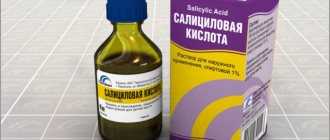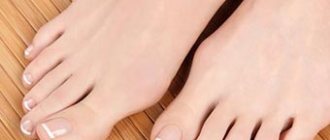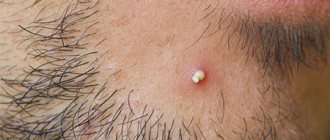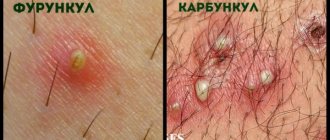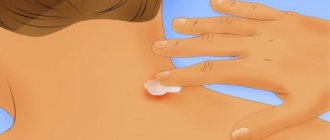What to do to make the boil ripen and burst faster: ointments, lotions, solutions
A furuncle is a purulent inflammation that is caused by staphylococci. It occurs more often in winter and spring, when the human body suffers from hypovitaminosis and a weakened immune system. Taking vitamin and mineral complexes, following personal hygiene rules, and treating the affected area with antiseptic creams and ointments will help speed up the maturation of the boil.
Stages of boil development
Normally, the process of “maturation” of an abscess takes 5-7 days. Boils form on the hairy areas of the body.
- Stage of pustule formation with infiltrate. Redness appears on the skin, which has no clear boundaries, and the bubble is painful when pressed. Pus forms inside.
- Stage of tissue necrosis. There is a rod visible on the top of the seal. The sore has the shape of a cone.
- The chirium rupture stage is accompanied by the release of exudate.
- Stage of healing and scarring. A crust will form within 2-3 days.
Timely consultation with a doctor will speed up the healing process. At the stage of pustule formation, treatment is aimed at accelerating the maturation of the abscess. After a breakthrough, antibacterial creams and ointments are prescribed; infection of the wound can lead to sepsis.
Why are unexploded ulcers dangerous?
If the disease drags on and the suppuration does not clear up after 10-12 days, you need to seek help from a surgeon. There is a danger that the infection can enter the blood and internal organs of a person. As a result of a purulent formation that cannot come out, problems such as blood poisoning and purulent meningitis often develop.
Sometimes the compaction freezes in development and turns into a hard lump that is unable to break through. In such cases, the surgeon makes an incision to remove the frozen boil.
Methods to accelerate maturation
Local treatment is used. Antibiotic therapy is used when chiria is found on the face and ear, when the diameter of the neoplasm is more than 5 cm. In other cases, drug therapy and physical procedures are performed to accelerate the maturation of the abscess.
Ointments and creams
The action of ointments and creams is aimed at relieving painful symptoms and drawing out pus. It is necessary to regularly smear the boil so that it goes away faster.
| Group of drugs | Pharmacological action, application | Representative drugs |
| Antibiotics |
Antibiotics promote the reverse development of the abscess or an early breakthrough |
|
| Antibacterial ointments | The drugs destroy the waste products of pathogenic microorganisms. Restore intracellular metabolism | Levomekol, dioxysol. When treating a boil on the eye (hordeolum), tetracycline ointment is used. |
| Pulling ointments | Promote the formation of pustules, the formation of a purulent-necrotic core | Ichthyol, heparin, syntomycin ointment. |
| Nonsteroidal anti-inflammatory drugs | Take for elevated temperature, fever, general weakness | Paracetamol, ibuprofen. |
| Drugs that accelerate scarring | Stimulating cell regeneration, preventing the formation of pathological scars | Contractubex. |
For treatment with ointments, it is advisable to use thin gauze bandages, otherwise local hyperthermia occurs (increased body temperature at the site of inflammation). Ointments can be applied to the damaged area.
Lotions
Compresses and lotions should not put pressure on the affected area. Use 3-4 times a day, duration – no more than 20 minutes a day. To make a new boil ripen faster, bandages are made from clean gauze and lubricated with herbal decoctions and creams.
How to prepare lotions:
- use lotions from herbal decoctions (chamomile, coltsfoot, lemon balm) - help reduce pain;
- compresses using ichthyol ointment accelerate ripening;
- lotions made from a yellow film of the bark of oak branches. The raw materials are poured with boiling water and steamed. Apply a piece of bark to the sore spot and fix it.
Solutions
Hypertonic sodium chloride solution is used to make the boil mature and rupture. It is necessary to treat the bandage with the solution and apply it to the affected area. If the medicine is not available, you can prepare it yourself by mixing 1 tbsp. salt with 0.5 tbsp. chilled boiled water.
Other
The physiotherapeutic method used is ultraviolet radiation (UVR). The boil matures faster and breaks through. The dosage is prescribed by the doctor.
Traditional methods that can be used to quickly break through a boil and relieve painful symptoms:
- smear the abscess with aloe juice at night;
- apply lotions from herbal decoctions;
- spread the new growth with baked onions (you can’t use fresh ones, it leads to burns);
- rinsing with brewed strong black tea;
- The boil will burst faster if you anoint the damaged area with grated boiled beets - cut in half and apply with the cut down. Beets draw out pus.
Before using traditional methods, a sensitivity test of the components is first carried out. To begin with, use the product on a healthy area of skin.
How to get rid of an abscess without getting blood poisoning
The word abscess is translated from Latin simply as an abscess. Doctors use this Latin term to describe an active inflammatory process in which a cavity filled with pus forms in living tissue.
Tavarius/Shutterstock
An abscess can occur in any part of the human body, including internal organs. But most often it affects the skin in the armpits, groin, area around the anus, base of the spine and gums near the teeth.
Inflammation around the hair follicle can also lead to the formation of an abscess - this type of abscess is commonly called a boil.
How to tell if you have an abscess
Symptoms of an external abscess developing inside the skin are usually obvious:
- it looks like a dense swelling, a “bump” that has grown under the skin;
- touching him is painful;
- the skin on the affected area turns red and feels hot to the touch;
- not always, but quite often you can see an accumulation of white or yellow pus under the stretched skin.
Extensive subcutaneous abscesses may also be accompanied by fever.
Abscesses that arise on internal organs or in the tissues between them are more difficult to recognize. Signs of an abscess in this case are vague and may vary depending on which organ is affected. For example, a liver abscess is often accompanied by jaundice, a yellowing of the skin of the body and the whites of the eyes. A lung abscess causes coughing and shortness of breath.
If we talk about the general and most common symptoms of an internal abscess, here they are:
- discomfort and pain in the area of the organ on which the abscess occurred;
- temperature increase;
- loss of appetite up to complete reluctance to eat;
- active sweating;
- distinct weakness.
Small abscesses often resolve on their own. However, much more negative scenarios are also possible.
When to Seek Help Quickly
Consult your physician or surgeon immediately if:
- the diameter of the subcutaneous abscess exceeds 1 cm;
- the abscess continues to grow and becomes more and more painful;
- inflammation occurs in the groin or anus;
- the abscess is accompanied by an increase in temperature.
Go to the emergency room or call 911 if:
- An abscess with a diameter of more than a centimeter appeared on the face.
- The temperature rose to 38.8 °C and above.
- You notice red streaks under the skin that spread outward from the abscess.
- In the area between the abscess and the breast, the lymph nodes were enlarged. For example, an abscess on the leg can cause enlarged lymph nodes in the groin area.
Such symptoms indicate that there is a high risk of blood poisoning. And this is a deadly condition.
What to do if you have an abscess
Ideally, any abscess, even if it looks small and relatively harmless, should be shown to a doctor - a therapist, surgeon or dermatologist.
The specialist will examine the abscess, assess its location and size, and analyze your health condition. And after that he will give recommendations on how and with what to treat the abscess in your particular case.
Please note: antibiotics or surgical removal of the abscess may be required.
Until you see a doctor, you can try to alleviate the condition with home methods.
Apply warm compresses
They will help reduce pain and accelerate the maturation of the abscess. Apply gauze soaked in warm water to the affected area 3-4 times a day for 15 minutes.
Use ointments
Apply antiseptic ointments with a pulling effect to the abscess. To find out which is better and safer to use in your case, consult your doctor.
Don't forget about antiseptic
If the abscess opens on its own, wash the wound with antibacterial soap and treat with any antiseptic, possibly alcohol-based. Then apply an antibacterial ointment (for example, levomekol or tetracycline) and apply a bandage. Wash the wound with warm water 2-3 times a day and apply warm compresses until it heals.
Trying to squeeze out the pus
Pressure can drive it deeper, which means the abscess will only increase in size.
Piercing an abscess with a needle
You can accidentally damage a blood vessel, which means pus will enter the bloodstream - with the expected consequences of sepsis.
Rely only on home methods
Do not continue home treatment if the abscess does not decrease in size (much less if it continues to grow) within a couple of days. Consult a physician as soon as possible.
What methods can harm
Furunculosis should be treated under the supervision of a doctor. It is not recommended to trust the advice of friends or dubious folk methods given on the Internet.
Methods (actions) that will aggravate the problem:
- improper use of medications. Ichthyol ointment is not applied after opening the abscess. Vishnevsky ointment is not used in areas with sensitive skin (face, groin area, ear, nose) and is not used in the first stage of boil development. At the stage of healing and granulation, it is forbidden to treat the wound with disinfectant solutions;
- improper use of home methods, failure to comply with proportions, incorrect combination with medications;
- treatment at home for boils with a diameter of more than 5 mm;
- untimely application, replacement of lotions;
- It is not recommended to warm up the chiryak yourself;
- washing the tumor using soap and household chemicals;
- You cannot open the abscess yourself. Piercing with an unsterile instrument leads to blood poisoning and sepsis.
What to do if the boil does not ripen
Normally, the boil matures and opens on its own after 7-10 days. If this does not happen, you need the help of a doctor. Depending on the patient's condition? The doctor will prescribe surgical treatment, antibiotics or physiotherapeutic procedures.
The abscess may not ripen for the following reasons:
- Incorrect formation of a purulent-necrotic core. The pus spreads deep into the skin, rather than upward.
- The boil is not ripe, you need to wait another 2-3 days. The maturation time is individual for each patient.
- The boil cannot break through due to its inconvenient location (intimate areas of the body, nose, ears).
- Thick skin at the top of the abscess; the boil cannot open.
The absence of a purulent-necrotic core may mean the transition of the boil to the abscess stage. The formation will not go away on its own, you need to urgently consult a doctor. The abscess can break through the skin and cause blood poisoning. To treat an abscess boil, only surgical treatment is used.
Treatment of the abscess is carried out after full maturation and the formation of a purulent-necrotic core. To quickly get rid of furunculosis, avoid touching the abscess with dirty hands or injuries during treatment. Wash your hands with antibacterial soap. The abscess will go away faster in the absence of irritating factors. It is recommended to avoid wearing clothes made of synthetic fabrics, to avoid friction and mechanical injuries to the boil.
Source
Prohibited Measures
The problem will remain uncured if the patient does not follow simple recommendations:
- you cannot open the abscess yourself - premature or inept opening of the abscess will lead to serious complications;
- a burst abscess must not be rubbed or tried to squeeze out the purulent core; the contents of the boil must leave the body on their own;
- Mechanical impact on the burst boil should be avoided - the patient should try not to put pressure on the boil;
- antibiotics should be taken only on the recommendation of a doctor;
- Do not swim or wet a burst boil.
Such actions can cause new development of bacteria in the lesion or provoke sepsis.
You can remove pus from the skin at home if you follow the following precautions:
- You cannot puncture the abscess. Do not squeeze out the contents from the infiltrate.
- It is prohibited to change the recommended dosage, frequency of use of drugs, folk remedies.
- If after 3 days there is no effect - the pus does not drain out - you should abandon home treatment and consult a surgeon. He will puncture or cut the bladder, remove the pathological fluid, and rinse the inflamed area with a syringe. The operation allows you to quickly get rid of the purulent plug and relieve pain.
- To prevent the bubble from growing or bursting, treatment and drawing out the contents must begin in the early stages of the disease. If an abscess occurs in the facial area, you should consult a doctor for advice. It will not be possible to draw out pus at home due to the high risk of complications.
Abscesses of any location should be examined in a hospital setting. Late appeal may result in negative consequences.
The article has been reviewed
by the site editors
Opening an abscess
Some patients ask: “How to open an abscess correctly?” Opening an abscess at home is prohibited. This event can cause serious complications.
An autopsy can cause the following complications:
- Skin furunculosis.
- Secondary abscess formation.
- Introduction of a second pathogen into the infection zone.
- Thrombosis of the cavernous sinus when the abscess is localized on the face.
- Sepsis is the entry of a pathogen into the blood.
Since autopsy cannot be performed at home, you should seek surgical help from a specialist.
Small abscesses can be treated conservatively. To “break through” the abscess, use one of the following drugs:
- Ichthyol ointment.
- Levomekol.
- Vishnevsky ointment.
- Baneocin.
What to do if you don’t have funds at hand? Some adherents of traditional methods of therapy recommend numerous recipes for alternative medicine.
Ichthyol ointment
The abscess matures faster when using the popular ichthyol ointment. This drug contains the substance ichthammol. The product has a number of positive effects:
- Kills bacteria in the area of inflammation.
- Causes irritation of nerve receptors, which reduces their sensitivity and reduces pain.
- Causes protein denaturation, which contributes to the accumulation of purulent masses.
- It is very well absorbed by the skin and mucous membranes, which allows the drug to penetrate into closed ulcers.
How to remove an abscess using ichthyol ointment? It must be applied externally 2 times a day. The effect is enhanced when applied under a sterile bandage.
A contraindication for use is an allergy to the active substance; in other cases, you can safely apply the medicine topically to the skin.
Levomekol
If the abscess does not break out on its own, you can use Levomekol ointment. This drug contains the antibiotic chloramphenicol and the antimicrobial agent methyluracil.
Due to the combined action of two strong agents, a rapid therapeutic effect is achieved:
- Medicines penetrate the skin and end up inside the purulent cavity.
- Due to the antiseptic effect, the destruction of pathogenic bacteria is achieved.
- The volume of purulent masses increases, which provokes its release to the surface of the skin.
- The abscess will break out fairly quickly with regular use of the ointment.
Small boils do not need to be opened by a doctor if you have this antibacterial ointment on hand.
Levomekol draws out pus well if you use it as follows:
- Apply a small strip of ointment to a sterile bandage folded several times.
- Apply it to the area of inflammation.
- A small aseptic bandage is applied on top.
- Dressing is done daily.
- The traction bandage should not become wet or dirty.
If you have a large abscess, you should consult a doctor.
Vishnevsky ointment
One of the best remedies that helps break out an abscess is Vishnevsky ointment. This substance with a characteristic odor contains birch tar, castor oil and xeroform. The drug occupies an intermediate position between a medicine and a folk remedy. The ointment was developed by a doctor and has been used in medicine for a long time.
The main property due to which the drug is used for abscesses is the ability of the ointment to accumulate pus. The medicine acts not only on microbes and kills them, but also on skin proteins. Under the influence of the drug, the abscess quickly opens and pus comes out of the skin.
Use the remedy for suppuration as follows:
- The ointment is applied to a gauze square and applied to the site of inflammation.
- An aseptic bandage is applied on top.
- The bandage should be changed 2 times a day.
- Remove the dressing if dirt accumulates on it or if it gets wet.
- Do not apply a large amount of product, which will saturate the bandage through.
- If you do not change the bandage for a long time, the ointment will dry out and a crust will form on top of the inflammation.
- This bandage can be removed only after wetting the crust with a chlorhexidine solution.
If you have several boils on the skin, you should contact a qualified specialist.
Baneocin
Abscesses also open well when treated with the popular antibacterial ointment - Baneocin. The drug consists of two antibiotics: bacitracin and neomycin. These substances work well with boils both in the ripening stage and if they burst on the surface of the skin.
The product is used as follows:
- Apply to the affected area of skin 4 times a day.
- Can be applied under a bandage to prolong the effect of the product.
- The product does not need to be washed off with water; you must wait until the drug is absorbed.
The drug is actively absorbed into the bloodstream and has a number of contraindications. You must read the instructions before use. In particular, it is used with great caution during pregnancy and breastfeeding.
Folk remedies
Many patients prefer to use predominantly traditional methods of treatment. Healers recommend using the following recipes to open ulcers:
- An onion baked in the oven is applied to the site of the abscess and secured with a bandage.
- Using laundry soap - soap the bandage and secure it overnight.
- Laundry soap is mixed with beeswax, honey and vegetable oil. It is heated and applied as an ointment.
- The leaves of the indoor ficus are scrolled in a meat grinder, applied to the abscess and secured with a bandage.
- Aloe juice is squeezed onto the surface of the skin and secured under a bandage up to 3 times a day.
- An alcoholic tincture of garlic helps the abscess break through with regular use.
These and numerous other recipes from traditional healers should be used after consulting a doctor.
Ointments for drawing pus from closed wounds
Purulent wounds, regardless of location, are accompanied by a number of pronounced clinical signs. If the patient experiences pain upon palpation of the wound, local hyperthermia is detected, and the color of the skin changes, then this indicates the accumulation of purulent masses under the skin. It is necessary to use a specialized drug that “sucks” the pus out.
It is worth knowing: when suppuration occurs, treatment is required with topical drugs that draw pus from the wound. If the patient exhibits symptoms of general intoxication - fever, headache, drowsiness/insomnia, lethargy, fatigue, then this indicates a serious course of the disease. External means alone are not enough; it is necessary to use tablets internally.
What ointment draws out pus? The modern pharmaceutical industry offers a large selection of medications - expensive and cheap, which have anti-inflammatory and antibacterial effects and promote the outflow of purulent secretions. The most effective drugs include Vishnevsky ointment, Levomekol, Ichthyol ointment, Sintomycin. Let's look at the listed medications in more detail.
Vishnevsky ointment
Balsamic liniment contains three active ingredients that enhance the healing effects of each other. Ointment for drawing out pus has anti-inflammatory, bactericidal, immunomodulatory effects. An antipurulent drug is used for festering pimples, pustules, boils, abscesses, etc.
Vishnevsky ointment is characterized by a rather weak antiseptic effect, but it promotes rapid tissue regeneration, accelerates the absorption of subcutaneous pus, as a result of which wound healing occurs faster.
What to do if an abscess breaks?
When it is possible to draw out the contents of the abscess, it is necessary to carry out a number of measures that will help speed up healing. These include:
- Removing purulent masses using a sterile turunda or napkin.
- Wash the wound with an antiseptic solution - chlorhexidine or hydrogen peroxide.
- Use of antibacterial ointments. Baneocin and Levomekol can be used. These products can be replaced with alternative ones; during this period, the degree of absorption of the drug into the skin is not so important.
- Applying an aseptic bandage to the wound and regular dressings. Prevents secondary infection.
If a person’s condition worsens, symptoms of intoxication and fever appear, it is necessary to consult a doctor.
Source
Treatment of boils with folk remedies
Boils appear on various parts of the skin, but most often they affect the back, face, abdomen, and neck. They can often be found on other parts of the body. Treatment of this disease can be carried out using traditional and folk methods.
Having boils causes significant discomfort and can cause serious health problems. Treatment is prescribed depending on the stage of development. To avoid blood poisoning and various infections that can cause death, you should not squeeze out the rod yourself and try to remove the pus. It is recommended to contact a medical facility at the first symptoms of the disease, as treatment is carried out with injections, ointments, and antibiotics. In advanced cases, surgical intervention is possible.
With the right approach, you can get rid of boils using folk remedies. Medications are applied to the affected area of the skin. When carrying out procedures, the location of the boils and the stage of their development must be taken into account.
Some folk remedies are almost as effective as modern medications. They have virtually no contraindications and are low in cost. The use of honey, liquid brewer's yeast or baked onions helps to quickly and painlessly remove pus. Despite the high effectiveness of traditional medicine, you should consult a doctor before starting treatment.
There are two methods to get rid of boils using honey. For the first treatment option, mix wholemeal flour, laundry soap and honey. Mix the ingredients until the mixture begins to resemble plasticine. The second option for honey therapy is to mix wholemeal flour and honey. Laundry soap should not be added.
The honey mass is applied to the affected area and fixed with a bandage for about 3 hours. The mixture can be used on different parts of the body. The procedure is carried out 2-3 times a day. The first positive result will be noticeable in a few days.
Treatment with brewer's yeast
Taking brewer's yeast helps saturate the body with iron, zinc, calcium, magnesium, and various vitamins. It is the lack of these substances that often provokes the appearance of boils. Taking yeast daily gets rid of boils and prevents their reoccurrence.
Baked onion treatment
Onions baked in the oven effectively remove pus from boils. The cooled head is cut into several slices, applied to the affected area before going to bed, and secured with a bandage. The skin is treated with hydrogen peroxide before the procedure. After the pus comes out, getting rid of the rod is much easier.
The methods listed above have fully proven their effectiveness, and if used correctly, a positive result is guaranteed. Treatment with traditional methods can be carried out separately or in combination with drug therapy.
Source
Syntomycin liniment
What ointment draws out pus from a closed wound? Sintomycin ointment helps cleanse the wound of purulent masses. The product effectively stops the inflammatory process, cleans the wound, and accelerates the healing process. The drug destroys pathogenic microorganisms because it disrupts the production of microbial cell walls.
Syntomycin ointment is used for the treatment of purulent wounds, purulent and inflammatory pathologies of the skin, and small ulcers. The drug has relatively many contraindications for use:
- Hypersensitivity to the composition;
- Liver/renal failure;
- Pregnancy;
- Breastfeeding;
- Child's age up to 4 months;
- Circulatory disorders in the brain;
- Fungal skin pathologies.
Synthomycin ointment is applied directly to the affected area, followed by a bandage that does not allow air to pass through. Frequency of application – 1-2 times a day. The bandage may not be removed for 24 hours. Side effects may occur with the use of the drug: angioedema, leukopenia, thrombocytopenia. If you have negative symptoms, you should immediately contact a medical specialist.

